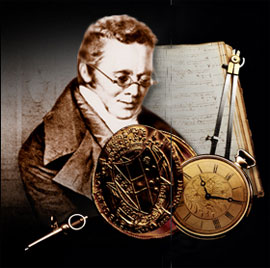

girard-perregaux
Historique de la maison d'horlogerie Girard-Perregaux
NouveautEs par annEe
L’histoire de la manufacture

Bien qu’orphelin très tôt, Jean-François Bautte aborde la vie avec détermination. Il apprend successivement les métiers de monteur de boîtes, guillocheur, horloger et orfèvre, et parfait son éducation.
En 1791, il signe dès 19 ans ses premières montres. A cette date sont attachées les origines de GIRARD-PERREGAUX.
Horloger de talent, Jean-François Bautte se fait connaître pour ses modèles de montres extra-plates et fonde à Genève une société manufacturière abritant sous son toit, de manière alors innovante, tous les métiers de l'horlogerie de l'époque. Avec une infinie simplicité, il y accueille les visiteurs les plus prestigieux dont la future reine Victoria. Industriel astucieux et homme d’affaires au caractère brillant, il commerce avec toutes les cours européennes qui font de lui l'un des horlogers les plus célèbres de l’époque.
En 1852, Constant Girard fonde la maison Girard & Cie. Deux ans plus tard, il épouse Marie Perregaux et, de l'union de leurs deux noms naît, en 1856 à La Chaux-de-Fonds, la Manufacture GIRARD-PERREGAUX.
En 1867, Constant Girard présente un Tourbillon qui remporte la médaille d’or de l’Exposition Universelle de Paris.
En 1889, son chef-d’œuvre, le fameux Tourbillon sous trois Ponts d'or, résultat de nombreuses années de développement, est primé à l’Exposition Universelle de Paris par une médaille d'or avant d'être jugé hors concours, car inégalable, en 1901.
A la fin des années 1960, GIRARD-PERREGAUX est l'une des rares manufactures à disposer d'une équipe R&D interne. Ce département de recherche va permettre à la marque de développer plusieurs mouvements révolutionnaires.
En 1966, GIRARD-PERREGAUX introduit au sein de sa famille Gyromatic le premier mouvement haute fréquence (36.000 alternances/heure). Les montres équipées de ce mouvement obtiennent naturellement d’excellentes performances de marche. Tant et si bien qu’en 1967, 70% des certificats de chronomètres délivrés par l’Observatoire de Neuchâtel sont attribués aux Chronomètres Haute Fréquence GIRARD-PERREGAUX.
1992 : L’entrepreneur italien, architecte et ancien pilote automobile Luigi Macaluso prend les rênes de GIRARD-PERREGAUX.
A une époque où beaucoup de sociétés horlogères suisses s'approvisionnent en mouvements ou ébauches chez des fournisseurs externes, GIRARD-PERREGAUX entreprend un effort massif pour développer sa logique manufacturière et introduit en 1994 une nouvelle famille de calibres ultra-plats nommés GP3000 et GP3100.
Despite being orphaned at a very early age, Jean-François Bautte was a determined young man. He was apprenticed successively as a case-fitter, engine-turner, watchmaker and goldsmith, and at the same time completed his education. In 1791, at the age of 19, he put his name to his first watches. This date marks the birth of
GIRARD-PERREGAUX.
Jean-François Bautte was a talented watchmaker and became well-known for his ultra-thin models. He founded a manufactory in Geneva which, in a revolutionary move, housed all the watchmaking crafts of the period under one roof. There, he modestly welcomed the most distinguished visitors of his day, one of whom was the future Queen of England, Victoria. A brilliant craftsman and a shrewd entrepreneur, he did business with all the courts of Europe, making him one of the most celebrated watchmakers of his time.

1852 Constant Girard founded Girard & Cie. Two years later, he married Marie Perregaux and, from the union of their two names, the GIRARD-PERREGAUX Manufacture was born in 1856 in La Chaux-de-Fonds.
1867 GIRARD-PERREGAUX's reputation rapidly spread, even as far as the new world. The Tourbillon presented by Constant Girard at the 1867 Universal Exhibition in Paris took the gold medal. In 1889, the famous Tourbillon with Three Gold Bridges, Constant Girard's masterpiece and the fruit of many years' labour, received the gold medal at another Universal Exhibition in Paris, before being judged ineligible in 1901 because it was too perfect.
At the end of the 1960's, GIRARD-PERREGAUX was one of the very few manufactures to have an internal R&D department. It has since developed several revolutionary movements for the brand. In 1966, GIRARD-PERREGAUX equipped its Gyromatic line with the first high-frequency movement (36,000 vibrations/hour). The watches equipped with this movement were extraordinarily accurate. So accurate, in fact, that 70% of the chronometer certificates issued in 1967 by the Neuchâtel Observatory were for
GIRARD-PERREGAUX's high-frequency chronometers.
1992 The Italian entrepreneur, architect and former racing driver, Luigi Macaluso, took over the reins of GIRARD-PERREGAUX.
At a time when many Swiss watch companies were buying movements and movement-blanks from suppliers, GIRARD-PERREGAUX concentrated on expanding its manufactory capacity. In 1994, it introduced the GP3000 and GP3100, a new family of ultra-thin movements.